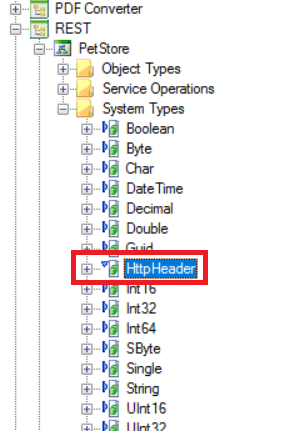Hi,
Are you able to register the REST service instance first with just the Descriptor Location to your Swagger definition? If so, you should see a service object generated under the REST service instance called HttpHeader. It is placed under System Types.

You can create a SmartObject from the HttpHeader service object, then use that SmartObject to generate a Http Header serialized JSON string that you can use.
If you cannot generate a HttpHeader SmartObject for some reason, this is an example of a HttpHeader serialized string containing exactly one header property and its value:
{"$type":"SourceCode.SmartObjects.Services.Endpoints.Common.HttpHeader, SourceCode.SmartObjects.Services.Endpoints.Common, Version=4.0.0.0, Culture=neutral, PublicKeyToken=null","Name":"HeaderProperty","Value":"Value"}
You just need to replace the header property and value that I bold with your own property and value.
This is another example which contains multiple header properties and values:
{"$type":"SourceCode.SmartObjects.Services.Endpoints.Common.HttpHeader[], SourceCode.SmartObjects.Services.Endpoints.Common, Version=4.0.0.0, Culture=neutral, PublicKeyToken=null","$values":[{"$type":"SourceCode.SmartObjects.Services.Endpoints.Common.HttpHeader, SourceCode.SmartObjects.Services.Endpoints.Common, Version=4.0.0.0, Culture=neutral, PublicKeyToken=null","Name":"HeaderProperty1","Value":"Value1"},{"$type":"SourceCode.SmartObjects.Services.Endpoints.Common.HttpHeader, SourceCode.SmartObjects.Services.Endpoints.Common, Version=4.0.0.0, Culture=neutral, PublicKeyToken=null","Name":"HeaderProperty2","Value":"Value2"},{"$type":"SourceCode.SmartObjects.Services.Endpoints.Common.HttpHeader, SourceCode.SmartObjects.Services.Endpoints.Common, Version=4.0.0.0, Culture=neutral, PublicKeyToken=null","Name":"HeaderProperty3","Value":"Value3"}]}
This one is a little tricky. If you want to add multiple header properties, you need to place them in an array. I have bold the array for your convenience. Inside the array, you should see multiple JSON objects with the same definition. Here is one of them:
{"$type":"SourceCode.SmartObjects.Services.Endpoints.Common.HttpHeader, SourceCode.SmartObjects.Services.Endpoints.Common, Version=4.0.0.0, Culture=neutral, PublicKeyToken=null","Name":"HeaderProperty1","Value":"Value1"}
If you want to add more header properties, just append the JSON object to the array, just as I have done below:
{"$type":"SourceCode.SmartObjects.Services.Endpoints.Common.HttpHeader[], SourceCode.SmartObjects.Services.Endpoints.Common, Version=4.0.0.0, Culture=neutral, PublicKeyToken=null","$values":[{"$type":"SourceCode.SmartObjects.Services.Endpoints.Common.HttpHeader, SourceCode.SmartObjects.Services.Endpoints.Common, Version=4.0.0.0, Culture=neutral, PublicKeyToken=null","Name":"HeaderProperty1","Value":"Value1"},{"$type":"SourceCode.SmartObjects.Services.Endpoints.Common.HttpHeader, SourceCode.SmartObjects.Services.Endpoints.Common, Version=4.0.0.0, Culture=neutral, PublicKeyToken=null","Name":"HeaderProperty2","Value":"Value2"},{"$type":"SourceCode.SmartObjects.Services.Endpoints.Common.HttpHeader, SourceCode.SmartObjects.Services.Endpoints.Common, Version=4.0.0.0, Culture=neutral, PublicKeyToken=null","Name":"HeaderProperty3","Value":"Value3"}, {"$type":"SourceCode.SmartObjects.Services.Endpoints.Common.HttpHeader, SourceCode.SmartObjects.Services.Endpoints.Common, Version=4.0.0.0, Culture=neutral, PublicKeyToken=null","Name":"HeaderProperty4","Value":"Value4"}]}
Quick tip: To help you better visualize the JSON strings, you can go to jsonviewer.stack.hu, paste the JSON strings in, then click on Viewer.



